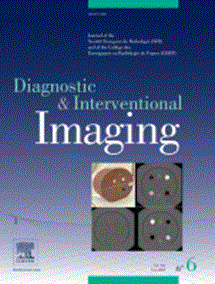Generative T2*-weighted images as a substitute for true T2*-weighted images on brain MRI in patients with acute stroke
IF 8.1
2区 医学
Q1 RADIOLOGY, NUCLEAR MEDICINE & MEDICAL IMAGING
引用次数: 0
Abstract
Purpose
The purpose of this study was to validate a deep learning algorithm that generates T2*-weighted images from diffusion-weighted (DW) images and to compare its performance with that of true T2*-weighted images for hemorrhage detection on MRI in patients with acute stroke.
Materials and methods
This single-center, retrospective study included DW- and T2*-weighted images obtained less than 48 hours after symptom onset in consecutive patients admitted for acute stroke. Datasets were divided into training (60 %), validation (20 %), and test (20 %) sets, with stratification by stroke type (hemorrhagic/ischemic). A generative adversarial network was trained to produce generative T2*-weighted images using DW images. Concordance between true T2*-weighted images and generative T2*-weighted images for hemorrhage detection was independently graded by two readers into three categories (parenchymal hematoma, hemorrhagic infarct or no hemorrhage), and discordances were resolved by consensus reading. Sensitivity, specificity and accuracy of generative T2*-weighted images were estimated using true T2*-weighted images as the standard of reference.
Results
A total of 1491 MRI sets from 939 patients (487 women, 452 men) with a median age of 71 years (first quartile, 57; third quartile, 81; range: 21–101) were included. In the test set (n = 300), there were no differences between true T2*-weighted images and generative T2*-weighted images for intraobserver reproducibility (κ = 0.97 [95 % CI: 0.95–0.99] vs. 0.95 [95 % CI: 0.92–0.97]; P = 0.27) and interobserver reproducibility (κ = 0.93 [95 % CI: 0.90–0.97] vs. 0.92 [95 % CI: 0.88–0.96]; P = 0.64). After consensus reading, concordance between true T2*-weighted images and generative T2*-weighted images was excellent (κ = 0.92; 95 % CI: 0.91–0.96). Generative T2*-weighted images achieved 90 % sensitivity (73/81; 95 % CI: 81–96), 97 % specificity (213/219; 95 % CI: 94–99) and 95 % accuracy (286/300; 95 % CI: 92–97) for the diagnosis of any cerebral hemorrhage (hemorrhagic infarct or parenchymal hemorrhage).
Conclusion
Generative T2*-weighted images and true T2*-weighted images have non-different diagnostic performances for hemorrhage detection in patients with acute stroke and may be used to shorten MRI protocols.
生成T2*加权图像替代急性脑卒中患者真实T2*加权图像的研究。
目的:本研究的目的是验证一种从扩散加权(DW)图像生成T2*加权图像的深度学习算法,并将其与真实T2*加权图像的性能进行比较,用于急性脑卒中患者的MRI出血检测。材料和方法:本研究为单中心、回顾性研究,包括连续入院的急性脑卒中患者在症状出现后48小时内获得的DW和T2加权图像。数据集分为训练集(60%)、验证集(20%)和测试集(20%),并按脑卒中类型(出血性/缺血性)分层。训练生成式对抗网络,利用DW图像生成生成式T2*加权图像。真实T2*加权图像与生成T2*加权图像之间的一致性由两个读取器独立分级为三类(实质血肿、出血性梗死或无出血),不一致性通过一致读取解决。以真实T2加权图像为参照标准,评估生成T2加权图像的灵敏度、特异性和准确性。结果:939例患者共1491台MRI(女性487例,男性452例),中位年龄71岁(第一四分位数,57岁;第三四分位数,81分;范围:21-101)。在测试集(n = 300)中,真实T2*加权图像与生成T2*加权图像在观察者内再现性方面无差异(κ = 0.97 [95% CI: 0.95-0.99] vs. 0.95 [95% CI: 0.92-0.97];P = 0.27)和观察者间再现性(κ = 0.93 [95% CI: 0.90-0.97] vs. 0.92 [95% CI: 0.88-0.96];P = 0.64)。共识读取后,真实T2*加权图像与生成T2*加权图像的一致性极好(κ = 0.92;95% ci: 0.91-0.96)。生成T2*加权图像灵敏度达到90% (73/81;95% CI: 81-96), 97%特异性(213/219;95% CI: 94-99)和95%准确率(286/300;95% CI: 92-97)用于诊断任何脑出血(出血性梗死或实质出血)。结论:生成型T2*加权图像与真T2*加权图像对急性脑卒中患者出血的诊断性能无差异,可用于缩短MRI方案。
本文章由计算机程序翻译,如有差异,请以英文原文为准。
求助全文
约1分钟内获得全文
求助全文
来源期刊

Diagnostic and Interventional Imaging
Medicine-Radiology, Nuclear Medicine and Imaging
CiteScore
8.50
自引率
29.10%
发文量
126
审稿时长
11 days
期刊介绍:
Diagnostic and Interventional Imaging accepts publications originating from any part of the world based only on their scientific merit. The Journal focuses on illustrated articles with great iconographic topics and aims at aiding sharpening clinical decision-making skills as well as following high research topics. All articles are published in English.
Diagnostic and Interventional Imaging publishes editorials, technical notes, letters, original and review articles on abdominal, breast, cancer, cardiac, emergency, forensic medicine, head and neck, musculoskeletal, gastrointestinal, genitourinary, interventional, obstetric, pediatric, thoracic and vascular imaging, neuroradiology, nuclear medicine, as well as contrast material, computer developments, health policies and practice, and medical physics relevant to imaging.
 求助内容:
求助内容: 应助结果提醒方式:
应助结果提醒方式:


